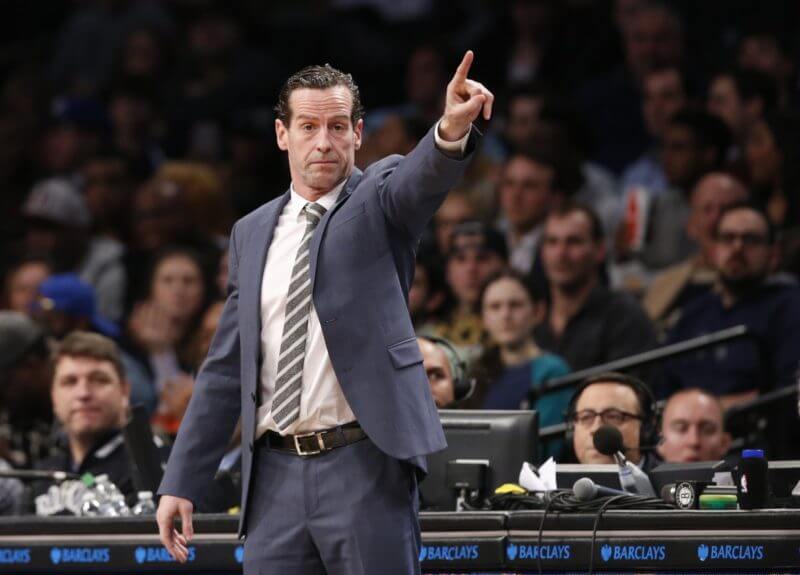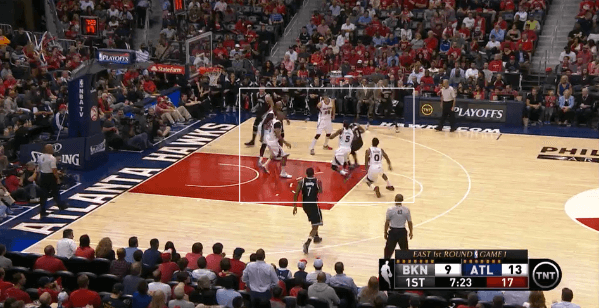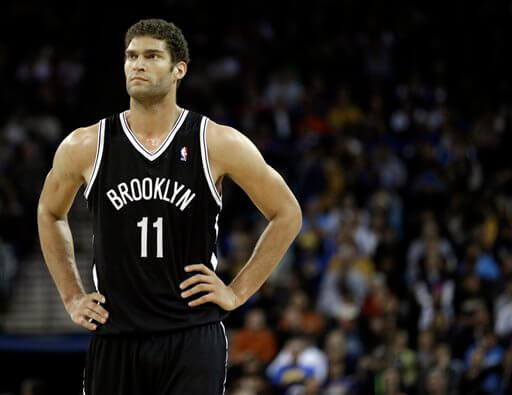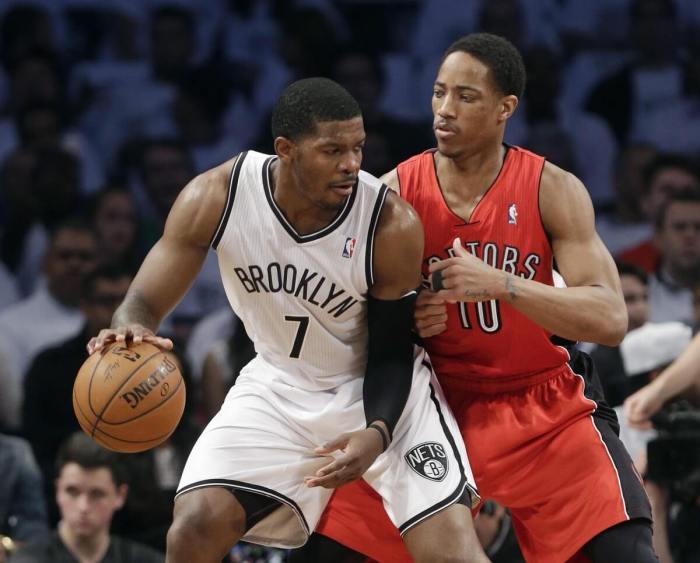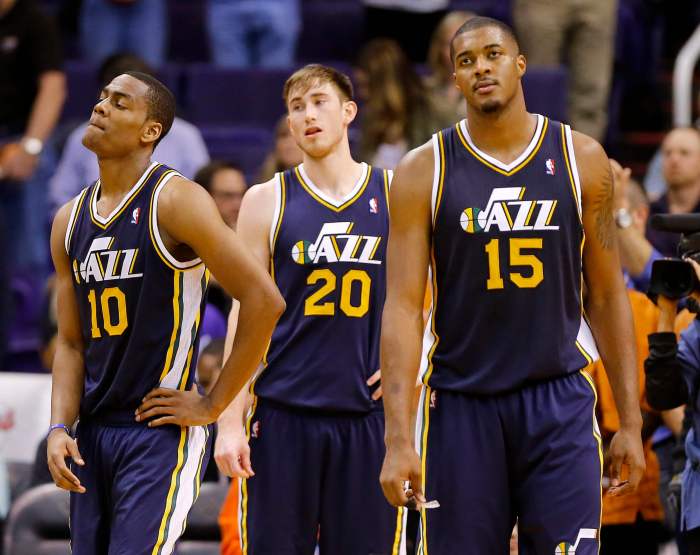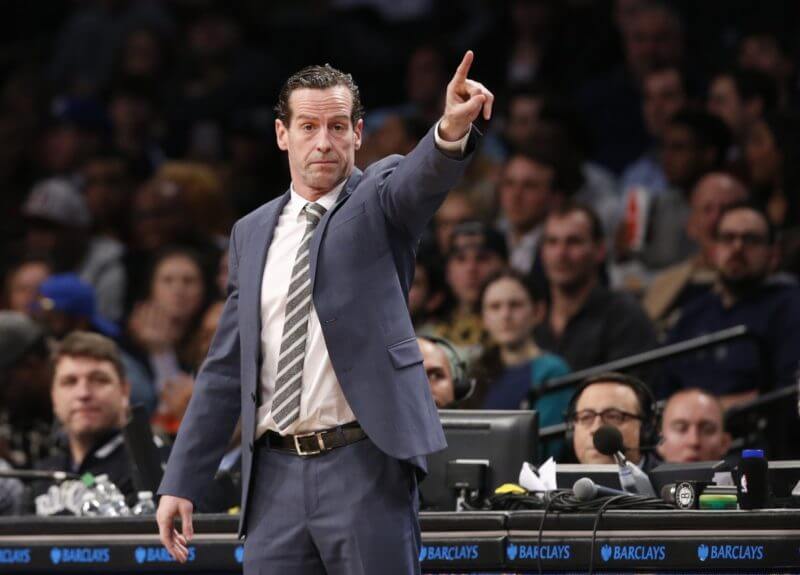
How Kenny Atkinson built a modern offense for the Brooklyn Nets, both for now and the future
The Brooklyn Nets are in flux. By rebuilding, the Nets are not just signing new players and staff — the entire franchise is changing. The players, head coach, and general manager are the most noticeable changes, but the makeover of the franchise runs deeper. Sean Marks and Kenny Atkinson have referred to the current Nets as a “program.” In college basketball, Coach K and the Duke Blue Devils are a program. So are Rick Pitino and Louisville, Roy Williams and UNC, Jay Wright and Villanova, and many others. But under the Nets’ program, there likely are less shady under-the-table deals than in men’s college basketball. In the NBA, the San Antonio Spurs are the “program,” that Sean Marks is sourcing as the Nets begin to grow. This is year one of the new Brooklyn Nets’ program. Kenny Atkinson is trying to install and teach a complicated motion offense, so there obviously have been growing pains — the record certainly shows that.
In Kenny Atkinson, Sean Marks hired a grandchild of the Gregg Popovich coaching tree and a child of the Mike D’Antoni tree. Atkinson has adopted principles of the Atlanta Hawks’ offense with a few D’Antoni-style philosophical strategies thrown in for good measure. The offense is the fastest paced in the league and while it has not led to success for the Nets, it has kept them competitive. On a team devoid of stars and sheer talent, the offense attempts to put players in situations to succeed. It’s a breath of fresh air, compared to when Lionel Hollins would run Deron Williams off the ball and have players take turns on stagnant isolation plays.
The Nets are finally modern.
The Offense — Philosophy and Roots
The Nets’ offense this season is complex — so, here’s way too much information on a team that hasn’t been successful. Kenny Atkinson took the skeleton of the Hawks’ “Spurs East” offense and injected it with D’Antoni-style speed. It’s Pace and Space meets a Spurs-esque motion. I’d love to think of a cool name for the offensive system, but I think winning has to come first before doing that. With the Hawks’ sets, the players often did not run any set plays and the system relies on the ability of the players to read and react to the opposing defense. The five players on the floor read when to screen, cut, pass, or attack and know where to find each other during the movement. It takes a lot of teamwork, but for the Spurs, that teamwork is part of their culture. The Hawks finished their season 6 games under .500 when Mike Budenholzer took over in 2013 and look at them now — so the offense takes time to learn and then even more to build chemistry.
In the Nets’ current offensive system, there are really no set plays in half court sets, just options. The D’Antoni philosophy comes into play in transition, affecting the team’s shot selection and clock control. Shots can come freely from all around the perimeter early in the shot clock, almost as soon as a player crosses the sideline hash mark. The Nets will also use dribble drives to the rim to set up open shooters or find cutters as well. This still leaves room for Brook Lopez post-ups and Sean Kilpatrick or Bojan Bogdanovic creating their own shots off the bounce. Anyone can be a ball handler and initiate a one-on-one depending on that matchup.
Atkinson said earlier in the season that if a player has a good look at the basket, he should shoot his shot — thus far, they have.
Strong + Weak Sets
The Nets run most (probably about 70%) of their offense starting with the “Strong” and “Weak” sets. These two sets come from Popovich and the Spurs and were the foundational pieces of the Hawks’ offense. Both of these sets use a four out, one in as the initial setup, involve the movement of the ball from side-to-side, and is followed by additional action.
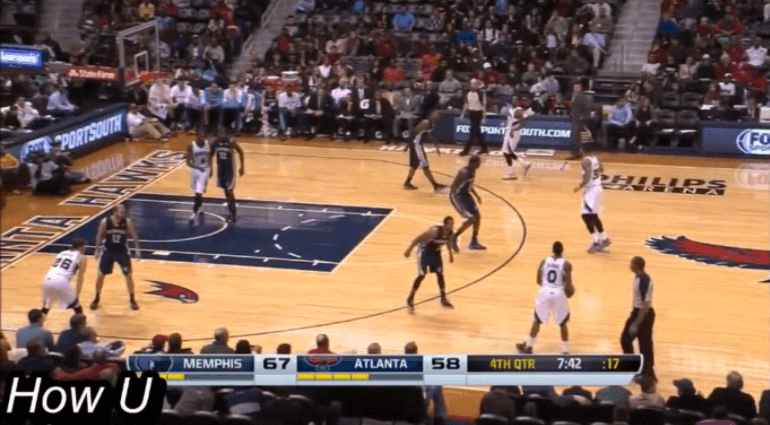
In Strong sets, a guard initiates the action by dribbling to a side with a big at the top of the key and another wing on the opposite side. The other big is on the block with the fifth player, usually a shooter, in the opposite corner, where the ball starts moving — or, towards the strong-side.
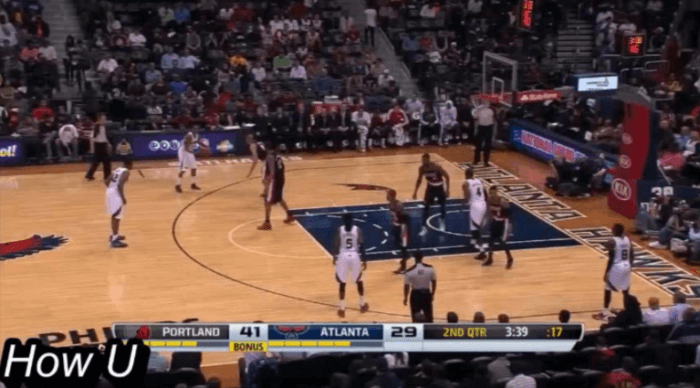
The Weak set has a similar side-to-side movement to start the possession, but instead of the corner wing on the same side as where the ball starts, he’s in the opposite corner — or, on the weak-side. The ballhandler that initiates the play is usually the point guard. Then, the ball is swung from the primary ball handler to the opposite side.
From here, there are different ways to attack and it’s up to the players to read the defense. This wing can look to dump it down low to the big to get a post-up or slip for a layup. The Hawks score the below bucket while in their Strong set:
https://gfycat.com/EnergeticGraveGemsbok
Of course, this is a favorite entry point for a classic Brook Lopez post-up. In previous years, Lopez had difficulty even getting position for post-ups, starting to back down a few feet inside the three-point line. Lopez or Trevor Booker can usually get the ball on the block if they ask for it coming out of a strong or weak-side set. The post-pass can come early in the shot clock, allowing enough time for additional movement or a reset.
If the big can’t find the proper position for a clear entry pass, the wing in the opposite corner can curl off of a double stagger screen to the top of the three-point line. From here, the wing that receives the ball can shoot it quickly or attack off the dribble. Atlanta often had Kyle Korver running off this action, typically.
Korver could come off the double screen for a three at the top of the arc:
https://gfycat.com/GregariousActiveGemsbuck
Or he could continue moving on the dribble, looking for his own shot…
https://gfycat.com/DeterminedAgreeableAnnelid
…or finding an open teammate diving to the basket.
https://gfycat.com/MammothOldHalicore
For the Nets, Joe Harris, when he starts, is usually the wing in the strong side corner. Similarly to Korver, Harris comes off of screens hard. He usually opts to take the ball off the dribble for in-between shots, rather than shooting it right off the catch.
If that doesn’t work, the current ballhandler can initiate another set. Atlanta used the play “Horns” as the secondary action off the initial play and that can leave even more options for scoring. It could lead to a give-and-go with one of the big men at the elbow, an open shot or drive to the rim by the big, or finding another teammate coming off an off-ball screen. From there, more motion can be initiated and, again, it’s up to the team to read and react to what the defense does.
They can run Horns into a give-and-go…
https://gfycat.com/WigglyOrganicBunny
…or cut more to get a shooter to come off of a curl screen:
https://gfycat.com/EsteemedMaleGroundhog
The Nets run Strong in the following play, with Bojan Bogdanovic coming off a second double stagger screen. Spencer Dinwiddie cuts from the strong-side on the initial action. It leads to an open, but ultimately missed, Trevor Booker three-point shot in the corner:
Below, the Nets run a modification of the Strong set and, instead of running Horns, Bogdanovic uses Booker as a screener in the pinch post, leading to a Lopez open three-pointer:
Next, the Strong set swings the ball back across the court and here Dinwiddie recognizes the double team and passes it to Lopez, who gets into the lane for a floater:
If the ball can’t be moved to the other side on the initial action, the corner player can come over and receive a handoff. Here, Kilpatrick is being denied the pass by Michael Kidd-Gilchrist. Booker hands it off to Bogdanovic, coming off a Dinwiddie screen, and forces a rushed pass after getting a quick double:
In the following set, Kemba Walker denies the ball from Dinwiddie on the swing. This leads to Kilpatrick coming off a Caris LeVert stagger screen and he uses Booker as a pick-and-roll partner:
The Weak set is similar to the Strong version, but it can be used to get the point guard a good look, whereas Strong is often used for a wing player. In Weak, instead of the corner wing coming off a double stagger screen, the initial ballhandler comes off a screen and can go to work from there. Jeff Teague was usually the guy doing this in Atlanta as his speed off of screens from a big allowed him to initiate the offense and create for himself or for his teammates — as you can see in these three gifs.
The Nets run “Weak” here, leading to a Randy Foye three-pointer early in shot clock. In it, Kilpatrick, who brought the ball up, comes off of a screen by Quincy Acy:
Next up, Isaiah Whitehead comes off of Rondae Hollis-Jefferson’s screen and gets the pass. Then he dumps it to Hollis-Jefferson and Bogdanovic comes across on a double stagger screen. This great ball movement culminates to an open Lopez three-pointer:
In this variation, Whitehead sets the weak-side screen to get Bogdanovic open at the elbow — ultimately, the ball is swung for a Foye three-point shot:
Obviously, Atkinson has added his own flair to the Hawks’ offense by speeding things up and looking for early shots and opportunities. The initial ball reversal can be done right as the players cross half court. Before the shot clock even reaches 20 seconds, the team may already have fired a shot from the perimeter or found a big down low. This occasionally allows for an easy bucket or a quick switch when the opposing defense doesn’t set up after their own offensive possession fast enough.
Inbound Plays + Horns
Of course, the Nets offense doesn’t run Strong and Weak sets every play — so next, we’ve got the aforementioned Horns. The ball handler is met with the two bigs at the elbows where can initiate a pick-and-roll, drive, or set up more movement by passing it to a big in a triangle offense pinch post. There are a lot of (maybe endless) options coming out of Horns — let’s take a look at one of the Nets’ successful attempts at it.
LeVert initiates Horns with Hollis-Jefferson slipping the screen and the defender, Frank Kaminsky, icing the ball handler. The rotation leaves Foye open in the corner for a three-point attempt:
The Nets have found success coming out of timeouts, something that’s been noted by the YES Network all season. Atkinson seems to excel at inbounds play calls and, even if players miss, they usually get a clean look or drive to the basket. In this play, Kilpatrick comes off of a rip screen from Lopez to initiate a pick-and-roll right at the free throw line:
Another inbounds play has Kidd-Gilchrist fighting two stagger screens from Booker and Lopez, thus leading to an open Kilpatrick three-pointer:
Drives, Pick-and-Roll, and Swings
This is where the fast pace and D’Antoni style comes in as, at any point in the offense, the players on the perimeter can come off the dribble and attack. While this may not always lead to an easy layup, it causes the defense to scramble and may leave someone open on the perimeter for a three-point, drive, or additional ball reversal.
Hollis-Jefferson, in recent games, has been attacking the basket well, typically leading to him getting to the rim or the free throw line. Coming out of some weak-side action, Hollis-Jefferson drives against Kaminsky, which causes a rotation to the rim. The small forward then dumps it off to Acy, who swings it to Bogdanovic for a three-point attempt:
Out of Strong, Weak or Horns, the pick-and-roll/pop can be initiated. There are some plays where the Nets run the pick-and-roll to start the possession and then make a decision as the play unfolds. Here, Whitehead finds Acy for an easy layup when Cody Zeller doubles the ballhandler:
Dinwiddie denies the screen from Lopez, but Charlotte doubles on the drive again, so Dinwiddie then finds a diving Lopez for the floater:
Very quickly, it’s easy to understand how, once it’s populated with better talent or chemistry, that an offense like Atkinson’s could really take off. Against the New Orleans Pelicans in last week’s stomping, the Nets executed to a tee — but, this season, that’s been more the exception rather than the rule.
Transition, Post-ups, and Isolation
The Nets’ offense is so fast that it seems like they’re always on a fast break and Zach Lowe of ESPN and Kevin O’Connor of The Ringer have even commented on the occasional effectiveness of the Trevor Booker coast-to-coast option:
Atkinson has encouraged guys to push the ball relentlessly, for better or for worse at times. Any player (other than the centers) can bring the ball up the court and initiate the offense or drive to the basket if the defense is napping. This is by design as the offense hasn’t really used a dominant ballhandler — particularly so thanks to the absence of Jeremy Lin.
The Brook Lopez post-up can also set up the offense, unsurprisingly. Coming off an entry pass, Lopez can start backing down his defender. The entry passer can cut away from the basket and set a screen for another wing along the top of the three-point line. If Lopez faces up, there usually are shooters at the weak-side wing and at the weak-side elbow. Lopez has also shown an ability to find cutters that dive to the basket after an entry pass or down screen. The Spurs ran similar action with Tim Duncan and are still doing so with LaMarcus Aldridge, a proven commodity at the absolute highest level.
Kilpatrick and Bogdanovic are the two players that use simple isolation the most. This may not be part of the motion offense, but it has been successful for both at points throughout the season. Kilpatrick does a decent job at using dribble moves to get to the rim or create enough space for a shot, while Bogdanovic uses the threat of his three-point shot to get defenses to decide to stay on him, where he can use long strides to get past the defender, or make a sagging defender pay by shooting a jumper with space.
So, is the offense any good?
Considering the personnel the Nets have, the Motion-X Pace and Space system can really maximize strengths and put players in positions to succeed. The speed of the offense can catch defenses sleeping or can take advantage of mismatches early in the shot clock. The motion offense, in theory, makes everyone an offensive threat. There is less standing around and more movement to work for an open shot, something that should be music to any Nets supporter’s ears.
In a season where star power has never been more evident, the Nets have been competitive in games without having a fair counter to the likes of James Harden, DeMar DeRozan, Stephen Curry, and Kevin Durant. With the constant motion, the players have to read and attack without second thought.
For the future, Atkinson’s offense can be much more successful, if given the personnel. The Hawks won 60 games with the very same offense without any above and beyond superstar, although Paul Millsap, Al Horford, and Teague worked in perfect symphony with Korver, the linchpin of most sets. With the NBA becoming longer and more athletic, a motion offense can create mismatches off of screen action or draw defenders far enough to leave someone open. It keeps everyone on the court involved, with loads of offensive possessions having all five players touch the ball. It’s a far cry from the pounding the basketball for 18 seconds and then attempting a contested midrange shot with 6 seconds left on the shot clock — Nets fans are all too familiar with that.
That all sounds great, right? Ball movement, open shots, drives to the rim, and sharing really has caused the team to overcome their talent disparity, yeah?
Well, obviously, it hasn’t.
An innovative, team-oriented system that was adapted from two successful philosophies has had no major effect on the wins-loss column this season for Brooklyn. There are different scapegoats in the Nets’ current rank as a bottom dweller, both in the standings and on the stat sheets. On the court, the offense isn’t always as smooth as the few and far between cherry-picked plays detailed here. By trying to emulate the Hawks and Spurs, the Nets have a clear goal of the style they want — but with the current roster, there’s still so much work to be done.
Sources
My entire knowledge of the Hawks’ offense comes from an amazing Reddit post that definitely didn’t get enough love. I used a few of the poster’s gifs to show how the Hawks used Strong, Weak, and Horns sets to generate their offense. He goes into much deeper detail and really delves into every option that can occur in the offensive system. You can check that out right here.
These videos are from the channels BBALLBREAKDOWN, Half Court Hoops, and Coach Daniel, respectively, and they helped me learn the offense inside out, both the good and bad parts.

